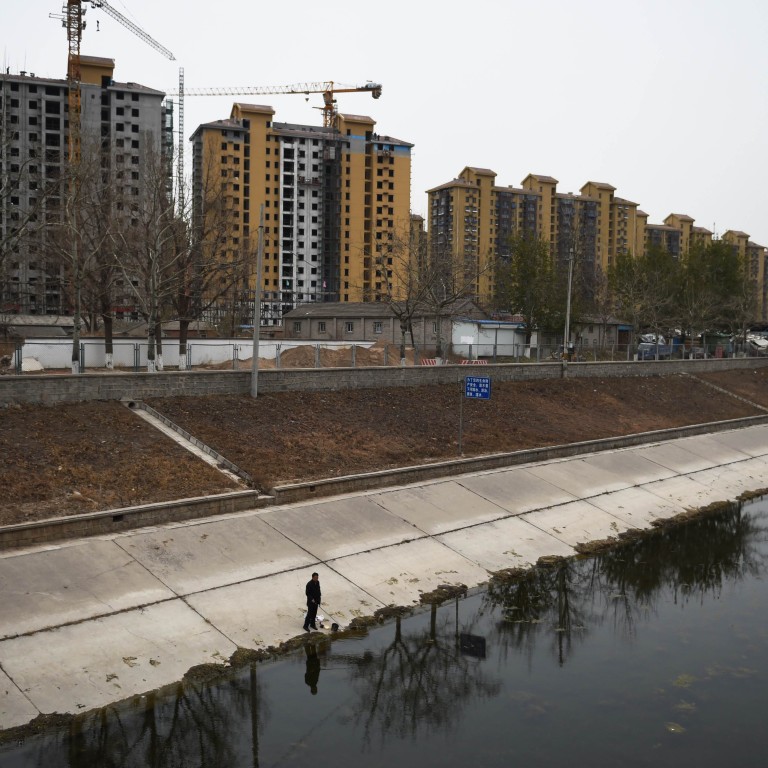
Land buying in China’s first-tier cities could drag them out of property downturn soon
“We expect land price in all tier-1 cities would continue to grow, very likely at a faster pace than last year” - Mizuho Securities
A spate of positive news and early signs of stabilisation of property sales have stirred up a land acquisition spree in first-tier cities of China where developers believe they will crawl out of the market downturn soon.
A large residential site in the southern part of Beijing sold for 8.63 billion yuan (HK$10.96 billion), setting a record for the most expensive plot in terms of total amount on Wednesday. The winning developer is a consortium comprised of China Resources and the Ping An insurance group.
The sale came two days after Wharf consortium paid 8.6 billion yuan for two adjoining sites in the same area.
“Land acquisition appetite is certainly higher in first-tier cities where land supply is limited,” said Alan Jin, an analyst at Mizuho Securities.
He noted land price in tier-1 cites were up even in 2014.
“We expect land price in all tier-1 cities would continue to grow, very likely at a faster pace than last year,” he said. Average land prices in first-tier cities, according to BNP Paribas, saw a year-on-year 56 per cent increase to 11,708 yuan per square metre last year, compared to just six per cent growth in ‘bad cities’ – like Sanya in Hainan- which is facing a glut in supply.
Jin said the land acquisition spree stared in late last year and the momentum has been strengthening since.
“Strong sales in December have heightened developers’ expectation that housing prices would resume growth soon in the first-tier cities,” he said.
The 40 basis point rate cut in November has started to materially lower mortgage rates and improve transaction volumes in first-tier and some second-tier cities.
“We believe another two 25 basis points symmetric rate cuts in 2015 and three reserve requirement ratio cuts, coupled with further relaxations of provident fund usage, tax cuts and possibly a partial relaxation of home purchase restriction in Tier 1 cities should cushion the downside,” Lee Wee-liat, head of research at BNP Paribas, wrote in the latest report.
In mid-2014, the restrictions on how many homes each family can buy, which was imposed in May 2010, have gradually been phased out in all but the four first-tier cities of Beijing, Shanghai, Shenzhen and Guangzhou.
Lee expects some 20 to 30 cities could see volume growth of 10 to 20 per cent and prices in these cities may also trend up in the second half this year.
Kenneth Pak Kei-yuen, a general manager at Midland Realty’s Beijing office, said the number of transactions in both the primary and secondary market in Beijing – one of the four first-tier cities still maintaining home purchase restrictions - last month climbed to this years’ peak since the easing of mortgage lending.
In December, there were 19,000 units which have been sold in the primary market, while 17,000 flats changed hands in the secondary market.
“Sales volume grew for the third straight month and prices have edged up three to five per cent from October,” he said.
Before the central bank eased the mortgage lending, sales volume in the primary and secondary market was just 5,000 to 7,000 deals done per month, he said.
On Wednesday, China Resources defeated more than 10 developers to secure the site at Fentai at a level 22 per cent higher than the government’s opening price of 7.07 billion yuan.
The site could yield a total gross floor area of 418,693 square metres, of which 286,000 square metres are designated for subsidised housing and 6,880 square metres that earmarked for education facilities.
After deducting the area for subsidised flats, analysts said gross floor area for commodity housing – which were sold based on market values - would be reduced to 126,000 square metres.
The price tag, according to property consultants, represents 38,000 yuan per square metre, compared to units in the area now going for about 40,000 yuan per square metre.
Mao Daqing, vice president at China Vanke and head of Beijing operation said earlier that there were 60 plots of land sold for above 25,000 yuan per square metre and 30 plots sold for more than 30,000 yuan per square metre since July 2012 in Beijing.
“It means they will have more than 70 projects lining up for pre-sale in the second quarter this year. These projects need to sell for 50,000 to 70,000 yuan per square metre before making a reasonable profit,” he said.

